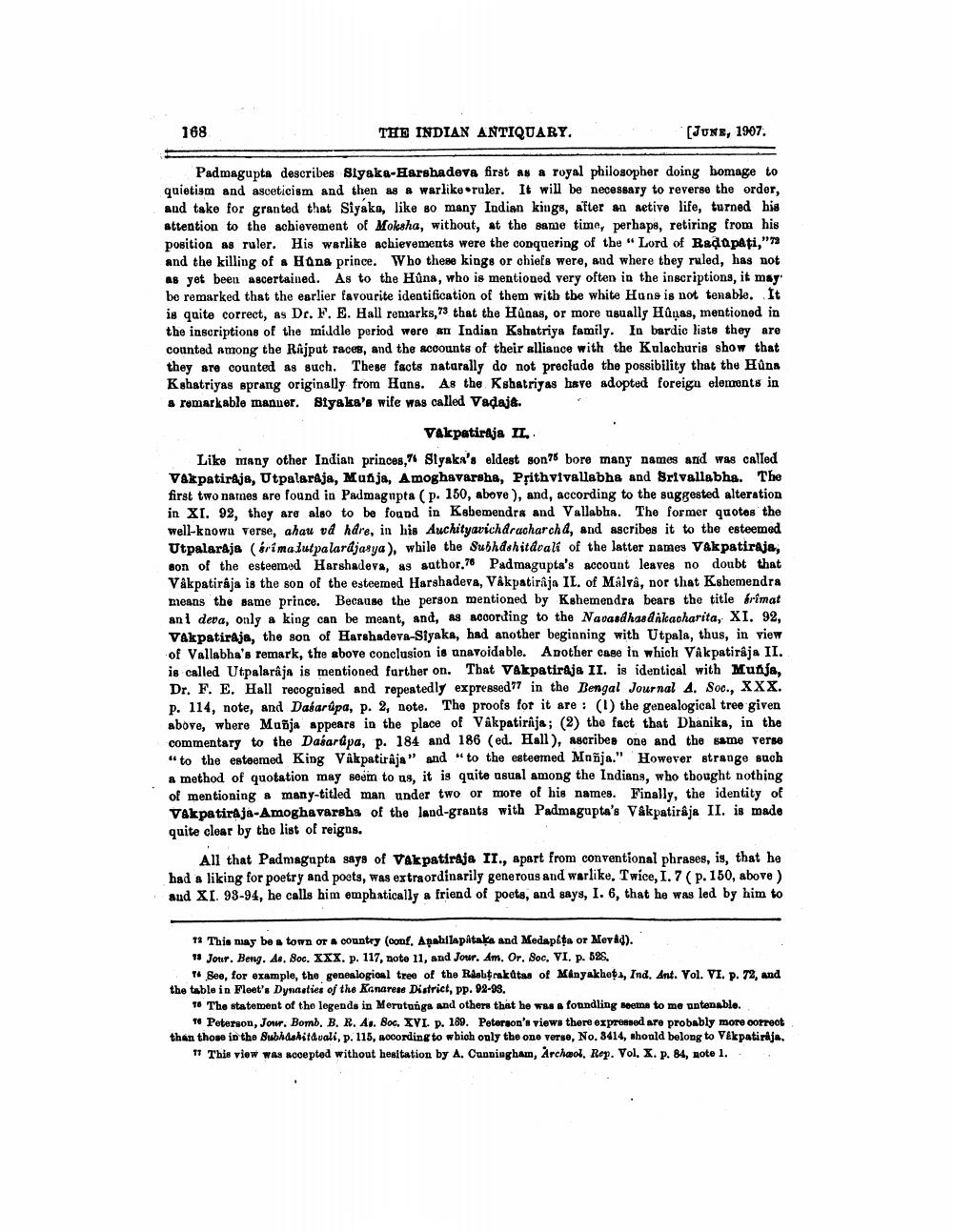________________
168
THE INDIAN ANTIQUARY.
(June, 1907.
Padmagupta describes Siyaka-Harsbadeva first as a royal philosopher doing homage to quietism and asceticism and then as a warlike ruler. It will be necessary to reverse the order, and take for granted that Siyaka, like so many Indian kings, after an aetive life, turned his attention to the acbievement of Moksha, without, at the same time, perhaps, retiring from his position as ruler. His warlike achievements were the conquering of the Lord of Radapati,"72 and the killing of a Hona prince. Who these kings or chiefs were, and where they ruled, has not as yet been ascertained. As to the Hûna, who is mentioned very often in the inscriptions, it may be remarked that the earlier favourite identification of them with the white Huns is not tenable. It is quite correct, as Dr. F. E. Hall remarks,73 that the Hûnas, or more usually Hûņas, mentioned in the inscriptions of the middle period were an Indian Kshatriya family. In bardic lists they are counted among the Rajput races, and the accounts of their alliance with the Kulachuris show that they are counted as such. These facts natarally do not preclude the possibility that the Hûna Kshatriyas sprang originally from Hans. As the Kshatriyas have adopted foreign elements in a remarkable manuer. Siyaka's wife was called Vadają.
Vakpatirsja IL Like many other Indian princes,74 Siyaka's eldest son75 bore many names and was called Vakpatirtja, Utpalaraja, Munja, Amoghavarsha, Prithvivallabha and Brivallabhs. The first two names are found in Padmagnpta (p. 150, above), and, according to the suggested alteration in XI. 92, they are also to be found in Kabemendra and Vallabha. The former quotes the well-known verse, ahau vd hdre, in his Archityavichdracharchd, and ascribes it to the esteemed Utpalaraja (Srimalutpalardjarya), while the Subhdshitdrali of the latter names Vak patiraja, son of the esteemed Harshadeve, as author.76 Padmagupta's account leaves no doubt that Vakpatirája is the son of the esteemed Harshadeva, VÅkpatiraja IL, of Malva, nor that Kshemendra means the same prince. Because the person mentioned by Kshemendra bears the title frimat ant deva, only a king can be meant, and, as according to the Navardhandikacharita, XI. 92, VAkpatiraja, the son of Harshadeva-Siyake, had another beginning with Utpala, thus, in view of Vallabha's remark, the above conclusion is unavoidable. Another case in which VAk patirája II. is called Utpalaraja is mentioned farther on. That Vakpatiraja II. is identical with Munja, Dr. F. E. Hall recognised and repeatedly expressed in the Bengal Journal A. Soc., XXX. p. 114, note, and Dasarúpa, p. 2, note. The proofs for it are: (1) the genealogical tree given above, whero Muñja appears in the place of Vâkpatiraja; (2) the fact that Dhanika, in the commentary to the Dasardpa, p. 184 and 186 (ed. Hall), ascribes one and the same verse "to the esteemed King Våkpatirâja" and "to the esteemed Moñja." However strange such a method of quotation may seem to us, it is quite asual among the Indians, who thought nothing of mentioning á many-titled man under two or more of his names. Finally, the identity of VAkpatiraja-Amoghavarshs of the land-grants with Padmagupta's Vakpatirája II. is made quite clear by the list of reigns.
All that Padmagupta says of Vak patirsja II., apart from conventional phrases, is, that he had a liking for poetry and poets, was extraordinarily generous and warlike, Twice, 1.7(p. 150, above) aud XI. 93-94, he calls him omphatically a friend of poets, and says, I. 6, that he was led by him to
11 This may be town or country (conf. Apabilapitaka and Medapta or MeyAd). 11 Jour. Beng. As. Soc. XXX. p. 117, note 11, and Jour. Am. Or. Soc. VI. p. 526
T Seo, for example, the genealogical tree of the Rialtraktas of Minyakhet, Ind. Ant. Vol. VI. p. 72, and the table in Floet's Dynasties of the Kanaress District, pp. 92-93.
• The statement of the legenda in Merutunga and others that he was a foundling seem to me untonable.
Peterson, Jour. Bomb, B. R. A.. Soc. XVI. p. 189. Peterson's views there expressed are probably more correct than those in the Subhdakitduali, p. 115, socording to which only the one verse, No. 8414, should belong to Vekpatirkja,
17 This view was accepted without hesitation by A. Cunningham, Archeol. Rep. Vol. X. p. 84, note 1.. .




